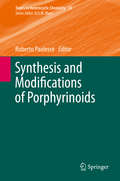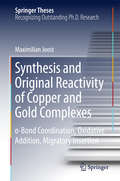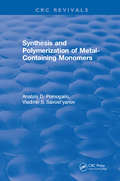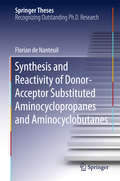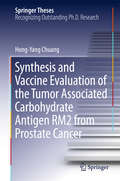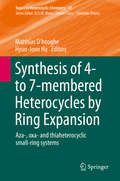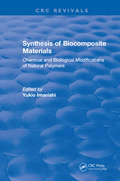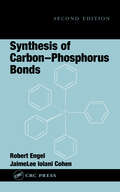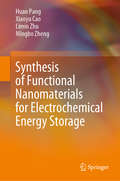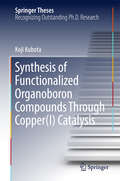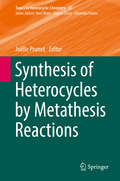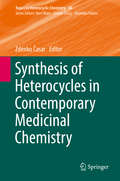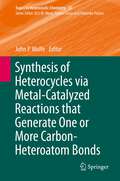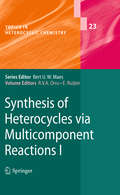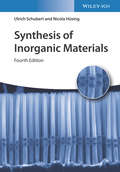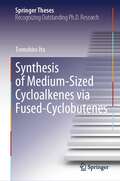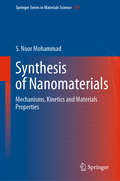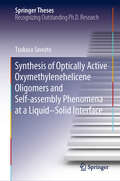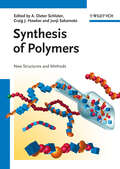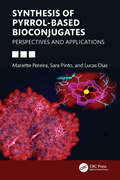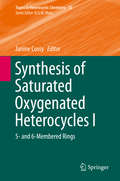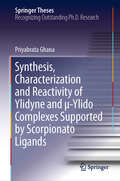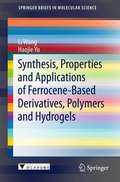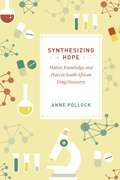- Table View
- List View
Synthesis and Modifications of Porphyrinoids
by Roberto PaolesseThe McMurry Reaction in Porphyrinoid Chemistry, by Kevin M. Smith Meso-tetraarylporphyrins: synthetic strategies and reactivity profiles based on nitro/amino substituents, by Maria da Graça Neves Functionalization of corroles, by José Cavaleiro Degradation pathways for porphyrinoids, by Jacek Wojaczynski Synthetic routes to porphyrinoids, by Sara Nardis Recent developments of non covalent porphyrin assemblies, by Donato Monti
Synthesis and Original Reactivity of Copper and Gold Complexes
by Maximilian JoostThis thesis addresses the coordination chemistry and reactivity of copper and gold complexes with a focus on the elucidation of (i) the metal-mediated activation of σ-bonds and (ii) the migratory insertion reaction. Both processes are of considerable importance in organometallic chemistry, but remain elusive for Cu and Au complexes. In this work, the author contributes significant advances: The first σ-SiH complexes of copper are experimentally and computationally characterized, yielding valuable insights into σ-bond activation processes for copper. Evidence for a highly unusual migratory syn insertion of unsaturated organic molecules into the gold-silicon bond of silylgold (I) complexes is provided and the corresponding mechanism identified. The intermolecular oxidative addition of σ-SiSi, σ-CC and σ-CX (X=halogen) bonds with molecular gold (I) complexes is studied in detail, effectively demonstrating that this reaction, usually considered to be impossible for gold, is actually highly favored, provided an adequate ligand is employed. The use of small-bite angle bis (phosphine) gold (I) complexes allows for the first time the oxidative addition of σ-CC and σ-CX bonds for gold (I). These results shed light on an unexpected reactivity pattern of gold complexes and may point the way to 2-electron redox transformations mediated by this metal, opening up new perspectives in gold catalysis.
Synthesis and Polymerization of Metal-Containing Monomers
by Anatoly D. PomogailoThis book overviews methods for the synthesis of metal-containing monomers with various types of metal bonds to the organic moiety of the molecule, such as ionic, covalent, donor-acceptor, and others. Published data on homopolymerization, copolymerization, and graft polymerization of these monomers are generalized. Synthesis and Polymerization of Metal-Containing Monomers discusses features typical of the molecular and structural organization of the resulting metal-containing polymers, their properties and the associated major applications, such as catalytical and biological activity, electrophysical characteristics, and thermal resistance.
Synthesis and Reactivity of Donor-Acceptor Substituted Aminocyclopropanes and Aminocyclobutanes
by Florian NanteuilThis thesis presents a general approach to accessing nitrogen-substituted hetero- and carbocycles. In short, the annulation reactions developed in the thesis make it possible to access nitrogen-substituted four-, five- and six-membered rings, all essential building blocks for the synthesis of bioactive molecules. Many natural products display a saturated polycyclic core allowing a well-defined arrangement of functional groups in space. As such, they can interact with biological targets with a high degree of affinity and selectivity, surpassing many synthetic drugs. Nevertheless, the efficient synthesis of such complex ring systems poses a challenge for organic chemistry. Through careful tuning of the electronic properties of a nitrogen donor group and a diester acceptor group, the first [3+2] annulation reaction between aminocyclopropanes and enol ethers or carbonyl compounds is now possible. The reaction proceeded under mild catalytic conditions, and the building blocks obtained can be found at the core of bioactive alkaloids, drugs such as Ramipril and biomolecules such as DNA and RNA. Thanks to the dynamic kinetic asymmetric annulation of aminocyclopropanes with enol ethers and aldehydes, access to enantioenriched compounds is also now possible. Lastly, a synthesis of donor-acceptor aminocyclobutanes via [2+2] cycloaddition using a cheap iron catalyst was developed, allowing them to be used in [4+2] annulations to access cyclohexylamines.
Synthesis and Vaccine Evaluation of the Tumor Associated Carbohydrate Antigen RM2 from Prostate Cancer
by Hong-Yang ChuangThis thesis focuses on the synthesis and vaccine evaluation of the prostate tumor- associated carbohydrate antigen RM2. The author first presents the use of the [1+2+3] one-pot sequential strategy to successfully synthesise the RM2 antigen and its analogues as single stereoisomers in every glycosylation step, producing good yields and stereoselectivity. He then introduces the conjugation of the synthetic RM2 antigen to the carrier protein CRM197 in an average number of 1-10 to create the prostate cancer vaccine candidate, which is combined with α-galactosylceramide C1, its analogue C34, or Alu. The results of the vaccination studies in mice are also described and indicate that the strongest anti-RM2 antigen titer is exhibited when one molecule of diphtheria toxin (DT) is conjugated with an average of 4. 7 molecules of RM2 antigen (DT-RM4. 7) and adjuvanted with the glycolipid C34. More importantly, the induced mouse antibodies mediate the effective complement-dependent cytotoxicity (CDC) against the prostate cancer cell line LNCap. The study presented in this thesis is the first ever to successfully synthesize this complex glycan molecule. Owing to the steric hindrance of the adjacent sialyl moiety, the introduction of two sialic acid units to the compact and rigid 3,4 di branched galactoside unit is very challenging and the β-selective and efficient glycosylation of the galactosamine moiety at the 4-position of di branched galactose is also problematic.
Synthesis of 4- to 7-membered Heterocycles by Ring Expansion
by Matthias D'Hooghe Hyun-Joon HaThe series Topics in Heterocyclic Chemistry presents critical reviews on present and future trends in the research of heterocyclic compounds. Overall the scope is to cover topics dealing with all areas within heterocyclic chemistry, both experimental and theoretical, of interest to the general heterocyclic chemistry community. The series consists of topic related volumes edited by renowned editors with contributions of experts in the field. All chapters from Topics in Heterocyclic Chemistry are published Online First with an individual DOI. In references, Topics in Heterocyclic Chemistry is abbreviated as Top Heterocycl Chem and cited as a journal.
Synthesis of Biocomposite Materials: Chemical and Biological Modifications of Natural Polymers
by Yukio ImanishiBiomaterials have been used for artificial-organ and bioreactor materials, and have gained importance for enhancement of human welfare. This book summarizes research devoted to creating useful biofunctional materials by chemical modification of natural polymers, and forecasts future development.
Synthesis of Carbon-Phosphorus Bonds
by Robert EngelSynthesis of Carbon-Phosphorus Bonds, Second Edition is a working guide for the laboratory, incorporating classical approaches with the recent developments of carbon-phosphorus (C-P) bond formation. These advances include the preparation of phosphoranes - specifically in the use of transient oxophosphoranes as intermediates in organophosphorus comp
Synthesis of Functional Nanomaterials for Electrochemical Energy Storage
by Huan Pang Xiaoyu Cao Limin Zhu Mingbo ZhengThis book provides a comprehensive review of functional nanomaterials for electrochemical applications, presenting interesting examples of nanomaterials with different dimensions and their applications in electrochemical energy storage. It also discusses the synthesis of functional nanomaterials, including quantum dots; one-dimensional, two-dimensional and three-dimensional nanostructures; and advanced nanocomposites. Highlighting recent advances in current electrochemical energy storage hotpots: lithium batteries, lithium-ion batteries, sodium-ion batteries, other metal-ion batteries, halogen ion batteries, and metal–gas batteries, this book will appeal to readers in the various fields of chemistry, material science and engineering.
Synthesis of Functionalized Organoboron Compounds Through Copper(I) Catalysis
by Koji KubotaThis book describes state-of-the-art borylation chemistry using copper(I) catalysis. Enantioselective reactions are included to afford a variety of functionalized, complex organoboronate esters, which will find wide application in asymmetric synthesis, drug discovery, and material science. Organoboron compounds are recognized as useful reagents in organic synthesis; therefore, great effort has been devoted to the development of a simple, mild, and efficient method for their preparation in the past several years. However, the synthesis of functionalized organoboron compounds remains a challenging issue because known reactions often require the use of highly reactive organometallic carbon nucleophiles. This book focuses on conceptually new, formal nucleophilic copper(I)-catalyzed borylation reactions with diboron compounds that show high selectivity and excellent functional group compatibility. Theoretical studies based on density functional theory calculations to understand the reaction mechanisms have also been described. Advances in this novel borylation chemistry will allow the rapid and efficient synthesis of complex molecules with potentially interesting properties in combination with the boron functionalization process.
Synthesis of Heterocycles by Metathesis Reactions
by Joëlle PrunetThe series Topics in Heterocyclic Chemistry presents critical reviews on present and future trends in the research of heterocyclic compounds. Overall the scope is to cover topics dealing with all areas within heterocyclic chemistry, both experimental and theoretical, of interest to the general heterocyclic chemistry community. The series consists of topic related volumes edited by renowned editors with contributions of experts in the field. All chapters from Topics in Heterocyclic Chemistry are published Online First with an individual DOI. In references, Topics in Heterocyclic Chemistry is abbreviated as Top Heterocycl Chem and cited as a journal.
Synthesis of Heterocycles in Contemporary Medicinal Chemistry
by Zdenko ČasarThe series Topics in Heterocyclic Chemistry presents critical reviews on present and future trends in the research of heterocyclic compounds. Overall the scope is to cover topics dealing with all areas within heterocyclic chemistry, both experimental and theoretical, of interest to the general heterocyclic chemistry community. The series consists of topic related volumes edited by renowned editors with contributions of experts in the field. All chapters from Topics in Heterocyclic Chemistry are published Online First with an individual DOI. In references, Topics in Heterocyclic Chemistry is abbreviated as Top Heterocycl Chem and cited as a journal.
Synthesis of Heterocycles via Metal-Catalyzed Reactions that GenerateOne or More Carbon-Heteroatom Bonds
by John P. WolfeSynthesis of Saturated Heterocycles via Metal-Catalyzed Alkene Carboamination or Carboalkoxylation Reactions, by John P. Wolfe Synthesis of Saturated Heterocycles via Metal-Catalyzed Alkene Diamination, Aminoalkoxylation, or Dialkoxylation Reactions, by Sherry R. Chemler Synthesis of Heterocycles via Metal-Catalyzed Wacker-Type Oxidative Cyclization Reactions of Alkoxy- or Amino-Alkenes, by Wanbin Zhang Synthesis of Saturated Heterocycles via Metal-Catalyzed Hydroamination or Hydroalkoxylation Reactions, by Lisa D. Julian Synthesis of Saturated Heterocycles via Metal-Catalyzed Allylic Alkylation Reactions, by Aaron Aponick Synthesis of Heterocycles via Metal-Catalyzed Cascade/Domino Reactions that Generate a C-N or C-O Bond, by Mark Lautens Synthesis of Saturated Heterocycles via Metal-Catalyzed Formal Cycloaddition Reactions that Generate a C-N or C-O Bond, by Jerome Waser
Synthesis of Heterocycles via Multicomponent Reactions II
by Romano V. Orru Eelco RuijterGéraldine Masson, Luc Neuville Carine Bughin Aude Fayol Jieping Zhu Multicomponent Syntheses of Macrocycles Thomas J.J. Müller Palladium-Copper Catalyzed Alkyne Activation as an Entry to Multicomponent Syntheses of Heterocycles Rachel Scheffelaar Eelco Ruijter Romano V.A. Orru Multicomponent Reaction Design Strategies: Towards Scaffold and Stereochemical Diversity Nicola Kielland Rodolfo Lavilla Recent Developments in Reissert-Type Multicomponent Reactions Jitender B. Bariwal Jalpa C. Trivedi Erik V. Van der Eycken Microwave Irradiation and Multicomponent Reactions Irini Akritopoulou-Zanze Stevan W. Djuric Applications of MCR-Derived Heterocycles in Drug Discovery
Synthesis of Inorganic Materials
by Ulrich S. Schubert Nicola HüsingIntroduces readers to the field of inorganic materials, while emphasizing synthesis and modification techniques Written from the chemist's point of view, this newly updated and completely revised fourth edition of Synthesis of Inorganic Materials provides a thorough and pedagogical introduction to the exciting and fast developing field of inorganic materials and features all of the latest developments. New to this edition is a chapter on self-assembly and self-organization, as well as all-new content on: demixing of glasses, non-classical crystallization, precursor chemistry, citrate-gel and Pechini liquid mix methods, ice-templating, and materials with hierarchical porosity. Synthesis of Inorganic Materials, 4th Edition features chapters covering: solid-state reactions; formation of solids from the gas phase; formation of solids from solutions and melts; preparation and modification of inorganic polymers; self-assembly and self-organization; templated materials; and nanostructured materials. There is also an extensive glossary to help bridge the gap between chemistry, solid state physics and materials science. In addition, a selection of books and review articles is provided at the end of each chapter as a starting point for more in-depth reading. -Gives the students a thorough overview of the fundamentals and the wide variety of different inorganic materials with applications in research as well as in industry -Every chapter is updated with new content -Includes a completely new chapter covering self-assembly and self-organization -Written by well-known and experienced authors who follow an intuitive and pedagogical approach Synthesis of Inorganic Materials, 4th Edition is a valuable resource for advanced undergraduate students as well as masters and graduate students of inorganic chemistry and materials science.
Synthesis of Medium-Sized Cycloalkenes via Fused-Cyclobutenes (Springer Theses)
by Tomohiro ItoThis book explains the existence of the intermediate using two approaches: computational chemistry and coordination chemistry. In this book, the author has developed new methods for synthesizing medium-sized cycloalkenes by utilizing the 4π-electrocyclic reaction of fused-cyclobutenes. The fundamental and most important strategy and feature of the work are as follows: first, cyclobutene is used as a readily available raw material with high-strain energy to generate more strained medium-sized cis,trans-cycloalkadiene molecules. Second, by judiciously selecting the reaction conditions, the short-lived intermediate (medium-sized cis,trans-cycloalkadiene) can be converted to medium-sized cis- or trans-cycloalkenes. For the former, the generation of the medium-sized cis,trans-cycloalkadiene intermediate is greatly affected by the substituent on the cyclobutene, and there are few examples of its generation confirmed at room temperature. Regarding the latter, the synthesis of trans-cycloalkenes is noteworthy in terms of establishing a new synthetic methodology and providing one of the few asymmetric synthesis methods, which has not been achieved before. Readers of this book can gain novel insights into strained molecules involved not only in small-sized cycloalkenes but also in medium-sized ones.
Synthesis of Nanomaterials: Mechanisms, Kinetics and Materials Properties (Springer Series in Materials Science #307)
by S. Noor MohammadThis book deals with the synthesis of nanomaterials with a strong focus on the underlying reaction kinetics and various synthesis mechanisms. It gives a detailed description of all major synthesis routes of many types of novel nanomaterials including nanowires, carbon nanotubes, semiconductor nanotubes, carbon nanobelts, nanofibers, nanorings, nanodots and quantum dots. In addition, it articulates the fundamental mechanisms of nanomaterials synthesis via vapor-phase, liquid-phase and solid-phase processes, highlighting the various strengths and weaknesses of each mechanism. This monograph provides the reader with a thorough review of the known state-of-the-art, along with a detailed comparison and analysis of all possible nanomaterials synthesis mechanisms. An important element of the book is how to obtain critical knowledge for controlling the morphology of nanomaterials and thereby fine tune their materials properties. The book is an ideal guide for graduate students and researchers new to the field seeking to establish or enhance their understanding of the physical and chemical fundamentals of nanomaterials synthesis mechanisms.
Synthesis of Optically Active Oxymethylenehelicene Oligomers and Self-assembly Phenomena at a Liquid–Solid Interface (Springer Theses)
by Tsukasa SawatoIn this book, the author demonstrates that double-helix formation and fibril film formation occur on solid surfaces as a result of the catalytic effect of the liquid–solid interface of the newly synthesized helicene oligomer. In addition, he shows that the double helix produced at the liquid–solid interface can be diffused into a solution to form a self-assembling material by means of mechanical stirring. Both types of formation are new chemical phenomena unique to liquid–solid interfaces not found in solutions. Detailed results are provided for new chemical reactions at liquid–solid interfaces, and gleaned from experiments performed using synthetic organic molecules. The book offers a useful reference guide to elucidating reaction mechanisms for researchers whose work involves chemical phenomena at a liquid–solid interface.
Synthesis of Polymers: New Structures and Methods (Materials Science and Technology: A Comprehensive Treatment)
by Junji Sakamoto Craig Hawker Uuml Ter Dieter A. SchlPolymers are huge macromolecules composed of repeating structural units. While polymer in popular usage suggests plastic, the term actually refers to a large class of natural and synthetic materials. Due to the extraordinary range of properties accessible, polymers have come to play an essential and ubiquitous role in everyday life - from plastics and elastomers on the one hand to natural biopolymers such as DNA and proteins on the other hand. The study of polymer science begins with understanding the methods in which these materials are synthesized. Polymer synthesis is a complex procedure and can take place in a variety of ways. This book brings together the "Who is who" of polymer science to give the readers an overview of the large field of polymer synthesis. It is a one-stop reference and a must-have for all Chemists, Polymer Chemists, Chemists in Industry, and Materials Scientists.
Synthesis of Pyrrol-based Bioconjugates: Perspectives and Applications
by Mariette M. Pereira Sara M.A. Pinto Lucas D. DiasIn recent years, the use of bioconjugation as strategy for development of more specific and directed drugs has been widely researched. Tetrapyrrolic macrocycles are one of the most common families of organic compounds applied in medicinal chemistry, specifically for diagnosis and therapy. For optimization of their efficiency as therapeutic molecules, it is relevant to promote their linking to biomolecules capable of targeting altered cells. This work brings a new dimension to the literature by combining structural modification of biomolecules and polymers with pyrrole-based compounds. It will be of great interest to academicians, industrialists, and undergraduate and graduate students of chemistry, biosciences, and pharmacy since, as apart from the theoretical aspects, it discusses experimental components.Features: Discusses methods for protein modification Useful for academicians, industrialists and undergraduate and graduated students of chemistry, biosciences, and pharmacy Explains the synthesis of pyrrole-based molecules
Synthesis of Saturated Oxygenated Heterocycles II
by Janine CossyThe series Topics in Heterocyclic Chemistry presents critical reviews on present and future trends in the research of heterocyclic compounds. Overall the scope is to cover topics dealing with all areas within heterocyclic chemistry, both experimental and theoretical, of interest to the general heterocyclic chemistry community. The series consists of topic related volumes edited by renowned editors with contributions of experts in the field.
Synthesis of Therapeutic Oligonucleotides
by Satoshi Obika Mitsuo SekineThis book presents the latest knowledge on a broad range of topics relating to the synthesis of natural and artificial oligonucleotides with therapeutic potential. Nucleic acid-based therapeutics are attracting much attention, and numerous therapeutic oligonucleotides, such as antisense oligonucleotides, siRNAs, splice-switching oligonucleotides, and nucleic acid aptamers, are being evaluated in clinical trials for the treatment of a variety of diseases. Synthesis of Therapeutic Oligonucleotides covers a broad range of topics in the field that are of high relevance to researchers, including the synthesis of natural and chemically modified oligonucleotides, the development of novel nucleic acid analogs, industrial scale synthesis and purification of oligonucleotides, and important aspects of chemistry, manufacturing, and controls (CMC). The aim is to provide new insights and inspire fresh ideas in nucleic acid chemistry that may ultimately lead to novel concepts and techniques and the discovery of more effective nucleic acid drugs. The book will be of high value for both established researchers in the field and students intending to specialize in nucleic acid chemistry research.
Synthesis, Characterization and Reactivity of Ylidyne and μ-Ylido Complexes Supported by Scorpionato Ligands (Springer Theses)
by Priyabrata GhanaThis book explores the development of the first open-shell heavier tetrylidyne complexes featuring a tetrel-centered unpaired electron, and unprecedented metallatetrylidynes containing a multiply-bonded, linear-coordinated single heavier tetrel atom embedded between two metal centers. The chemistry of compounds featuring triple bonds of the heavier Group-14 elements Si–Pb with transition metals is a very challenging research area, which combines modern molecular main-group element with transition-metal chemistry, and is of fundamental importance for the understanding of chemical bonding. During the last 15 years, the research in this area has witnessed considerable progress in isolating a series of closed-shell tetrylidyne complexes. However, despite numerous attempts, open-shell tetrylidyne complexes and heavier group 14 element congeners of metallacarbynes and carbide complexes remained inaccessible. In this book, readers will find more about the synthesis, full characterization and reactivity studies of these novel complexes that uncovered a plethora of exceptional products, including a novel m3-silicido complex, the first dimetallasilacumulene with a linear, two-coordinated single silicon atom and the first compounds of planar tetracoordinated silicon (ptSi) (Anti-van’t Hoff-Le Bell Silicon). Readers will also learn about the isolation and full characterization of the first room-temperature stable disilavinylidene, a silicon analogue of the very reactive vinylidenes (R2C=C:), and the first intermetallic plumbylidyne ligand transfer reactions.
Synthesis, Properties and Applications of Ferrocene-based Derivatives, Polymers and Hydrogels (Springerbriefs In Molecular Science: Chemistry of Foods)
by Li Wang Haojie YuAfter an introduction to their fundamentals and history, this book systematically reviews ferrocene-based compounds, polymers and hydrogels. It explains in detail the synthetic methods for and properties of each ferrocene-based compound, polymer and hydrogel, and also extensively discusses their applications, including electrochemistry, catalysis and sensors. An outlook chapter on remaining challenges and future perspectives rounds out the coverage. <P><P> Providing a wealth of valuable information on ferrocene-related studies, the book appeals to researchers, professionals and graduate students working in the fields of organic and polymer chemistry, as well as materials science.
Synthesizing Hope: Matter, Knowledge, and Place in South African Drug Discovery
by Anne PollockSynthesizing Hope opens up the material and social world of pharmaceuticals by focusing on an unexpected place: iThemba Pharmaceuticals. Founded in 2009 with a name taken from the Zulu word for hope, the small South African startup with an elite international scientific board was tasked with drug discovery for tuberculosis, HIV, and malaria. Anne Pollock uses this company as an entry point for exploring how the location of scientific knowledge production matters, not only for the raw materials, manufacture, licensing, and distribution of pharmaceuticals but also for the making of basic scientific knowledge. Consideration of this case exposes the limitations of global health frameworks that implicitly posit rich countries as the only sites of knowledge production. Analysis of iThemba identifies the problems inherent in global north/south divides at the same time as it highlights what is at stake in who makes knowledge and where. It also provides a concrete example for consideration of the contexts and practices of postcolonial science, its constraints, and its promise. Synthesizing Hope explores the many legacies that create conditions of possibility for South African drug discovery, especially the specific form of settler colonialism characterized by apartheid and resource extraction. Paying attention to the infrastructures and laboratory processes of drug discovery underscores the materiality of pharmaceuticals from the perspective of their makers, and tracing the intellectual and material infrastructures of South African drug discovery contributes new insights about larger social, political, and economic orders.
